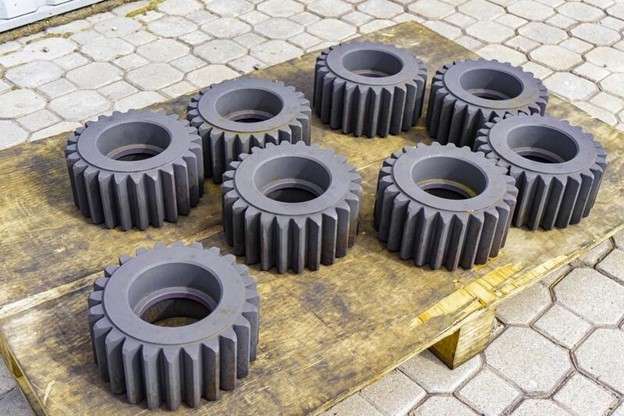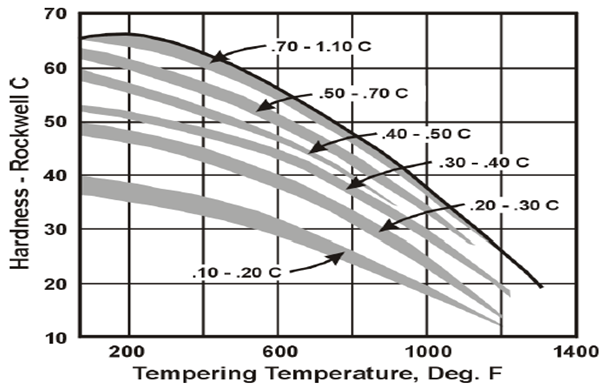
Heat treatment process
Hardness plays a significant role in the functionality of several applications, from a knife to aerospace components. In some applications, the original hardness, strength, elasticity, machinability, and other metal properties might not be enough. There comes the role of steel heat treatment, which helps to customize physical and mechanical properties at the desired level.
Material heat treatment can be done before or after manufacturing based on the required properties. For example, annealing improves machinability and is carried out before manufacturing.
This article will discuss heat treatment processes, services, types, steel heat treating charts, and many more in-depth.
Heat Treating Steel
Manufacturers use the material heat treatment process to improve the mechanical properties of metal parts. However, steel heat treating service is most common among metal heat treatment services. Heat treatment of steel parts allows altering the various properties according to the need of applications.
What is meant by steel heat treatment?
Heat treatment of any material refers to heating the workpiece at a high temperature, followed by the cooling process. The desired outcomes depend on the cooling rate, heating temperature, and other variables.
The heat treatment process changes the micro-structure of metal, which alters its physical and mechanical properties. It involves three different stages, heating, soaking, and cooling.
Stage 1: Heating
Heating steel to a predetermined temperature is the initial step in the heat treatment process. It can be done with a furnace, flame, torch, or induction heating. The steel grade and required properties determine the temperature at which the steel is heated. For example, steel is heated up to 1500 F for hardening.
Stage 2: Soaking
Once the steel parts reach the predetermined temperature, they are held at that temperature for a specific time, called soaking. The primary purpose of this step is to allow the steel to alter its microstructure. Since soaking controls how much the steel will harden, this step is crucial to the success of the hardening process.
However, the soaking time entirely depends on the required properties and material thickness. For example, steel hardening requires several minutes of soak time.
Stage 3: Cooling
Cooling of heated steel parts stabilizes the microstructure changes during heat treatment. So, the cooling approach directly affects the outcomes because microstructure change leads to a change in mechanical properties.
There are many cooling approaches, such as air cooling, oil quenching, and water quenching. Each of these cooling techniques results in unique, different properties changes. For instance, quenching makes steel hard and brittle, whereas air cooling can retain ductility and toughness.
How to ensure a successful heat treatment?
Metal heat treatment services are complicated processes requiring several considerations to get a quality result. Following are some essential tips to ensure a successful heat treatment.
- Clean the surface of metallic parts before heating. A successful material heat treatment service must ensure the surface is free from contamination to produce a quality result.
- Better control of temperature and the heating rate is vital for successful heat treatment. So, maintain the temperature in every heating stage accurately.
- Fix the soaking time with consideration of the metal type and desired outcome.
- Rapid cooling increases the hardness and strength but also increases the risk of cracking and distortion. Therefore, choose the cooling approach and rate carefully.
- Consider the post-processing approaches, such as tempering, stress relieving, or surface treatment, according to the application’s needs.
The Hardening Process

Hardened steel parts
Steel hardening is one of the essential applications of metal heat-treating services; generally, hardening also refers to heat treatment. The hardening process involves heating steel parts at high temperatures and rapid cooling (quenching). The heating of metal at high temperatures changes the crystal structure, and rapid cooling stabilizes that change permanently to increase the hardness.
However, several other heat treatment types exist besides hardening (or quenching). Let’s discuss each of them in detail.
Annealing
An annealing type of heat treatment is used to soften steel and increase its ductility. This process involves heating the steel to a particular temperature and maintaining it there for a specific time.
The steel is next gradually cooled at room temperature. It is best to approach to reduce internal stress and increase machinability. Low-carbon steels and non-ferrous metals are typical materials used in the process.
Quenching
Quenching is a type of metal heat treatment used to increase the hardness and strength of steel. The process involves heating the steel to a specific temperature and then cooling it rapidly by immersing it in a liquid such as water, oil, or brine. The rapid cooling rate causes the steel to transform structurally, resulting in increased hardness and strength.
Although quenching improves the hardness and strength, there is also a risk of brittleness and racking. Therefore, tempering is often applied after the quenching.
Tempering
Tempering heat treatment service provides toughness and reduces the hardness of steel. The procedure entails dropping the steel’s temperature below its critical point and maintaining it there for a predetermined time. After that, the steel is cooled in the air.
Tempering the steel lowers the internal stress and improves its elasticity & toughness while reducing its brittleness.
How does heat treatment increase steel hardness?
When steel is heated to a specified temperature and kept there for a specific amount of time, the carbon atoms in steel will diffuse and form new structures, such as austenite. After that, quenching in a cooling medium like water or oil changes the austenite phase into a more rigid and durable martensitic phase.
The heat-treated steel becomes harder and more brittle due to the carbon atoms’ low ability to return to their original structure due to the rapid cooling rate.
Try Prolean Now!
Steel Hardening Services
Most manufacturers offer steel hardening services since it is the most frequently used metal in high-strength applications. Hardening is typically done once the parts are manufactured because hardening can make the machining process. However, hardened steel can be tempered later to enhance its machinability.
Now, let’s discuss some of the standard steel hardening services.
- Quenching and tempering service: It increases the strength and hardness of steel, making it more resistant to wear and tear. The hardened steel can withstand high levels of stress and harsh environments.
- Case hardening service: It is used when the steel surface needs to be hardened to maintain a ductile core. There are several ways to achieve case hardenings, such as carburizing or nitriding. The case hardening is ideal for applications where the steel needs to be highly wear-resistive but still flexible and shock-resistant in the core.
- Induction hardening service: Induction hardening uses an induction coil of a high-frequency electromagnetic field to heat the steel inside it, followed by a quick cooling process. This metal heat treating service is popular for applications where only a particular portion of the parts must be hardened, like shafts or gears.
Read more: Precipitation Hardening: Process, Types & Benefits
Heat treatment charts are essential for the quality control of steel hardening services.
Heat Treating Steel Charts

Heat-treating steel chart
Heat-treating steel charts refer to the graphical representations of the temperature and cooling rate’s effects on the microstructure and steel properties. In addition, each type or grade of steel has different charts.
The steel’s heat treating or treatment chart contains a series of curves or lines indicating the temperature range and cooling rate required to achieve a specific property, such as hardness, toughness, or machinability. For example, a graph might contain hardness on the x-axis and corresponding temperature on the y-axis to display the effect of heating on hardness.
How to read and use heat-treating steel charts?
As mentioned, the chart contains the temperature, heating, or cooling rate corresponding to properties. You can analyze the different effects on steel properties with the heat treatment chart. Furthermore, the chart can contain additional information, such as critical temperature, austenite phase, and martensite phase.
Therefore, a steel heat treating chart is very beneficial to understand the steel heat treatment parameter like required temperature and heating or cooling rate to customize the properties at the desired level.
Examples of standard heat-treating steel charts
Steel heat-treating services involve using several heat-treating charts according to the steel type and intended properties after treatment. Following are the example of some common charts;
- Hardenability chart: It shows the depth to which a particular type of steel can be hardened with quenching. This chart is used to determine the best quenching medium and rate of cooling to obtain the desired hardness at a certain depth.
- Time-temperature transformation (TTT) chart: This chart shows how long it takes for a specific type of steel to at different temperatures to change from one phase to another, such as austenite to martensite. It is helpful to determine the suitable hardening processes to achieve the desired properties.
- Continuous cooling transformation (CCT) chart: The CCT chart depicts the change of austenite into various phases as the steel cools at a certain pace. This chart calculates the cooling rate required to obtain the desired microstructure and characteristics.
Conclusion
Heat treatment involves heating metallic parts at specified temperatures, followed by controlled cooling. Various metal heat treatment services regarding the metal type and intended properties are in practice. Processing steel and steel parts with heat treatment methods allow for customizing their mechanical properties, such as strength, hardness, elasticity, durability, corrosion resistance, abrasion resistance, and many more.
Understanding and use of steel heat-treating charts are crucial to obtain quality results. The chart helps to fix the heat treatment variables corresponding to the desired properties, such as temperature, heating or cooling rate, and phase transformation. At Proleantech, we provide heat-treating services for your sustainable steel components. So, do not hesitate to contact us if you need heat treatment service
FAQs
How to heat treat 1084 steel?
1084 steel is a popular high-carbon steel that is usually heat-treated to increase its hardness and strength for different applications. The process entails heating the steel at a temperature of 1,500°F (approx.), holding it there for 10 to 15 minutes, and rapid cooling.
What are the common steel heat treating services?
The common steel heat-treating service includes quenching, tempering, induction hardening, and case hardening. However, selecting the proper process entirely depends on the need of the particular application.
How heat treatment impacts the steel properties?
The heat treatment process involves heating steel at high temperatures and cooling, which causes the microstructure changes (Basically, crystal structure). As a result, structure change leads to a change in physical and mechanical properties.
Related: Why Small-batch CNC Machining is an Advantage for Your Business?




0 Comments